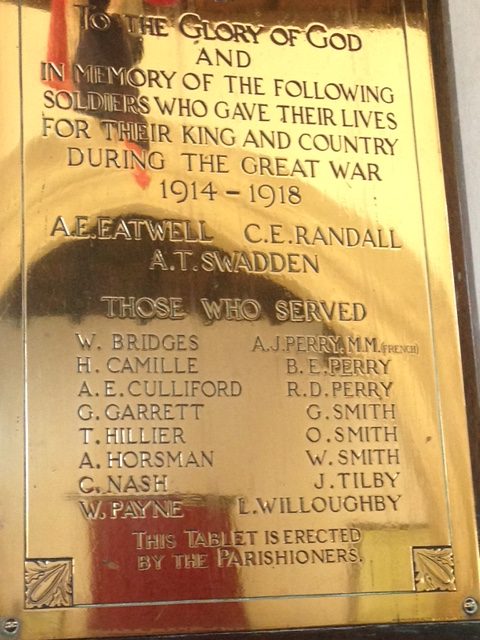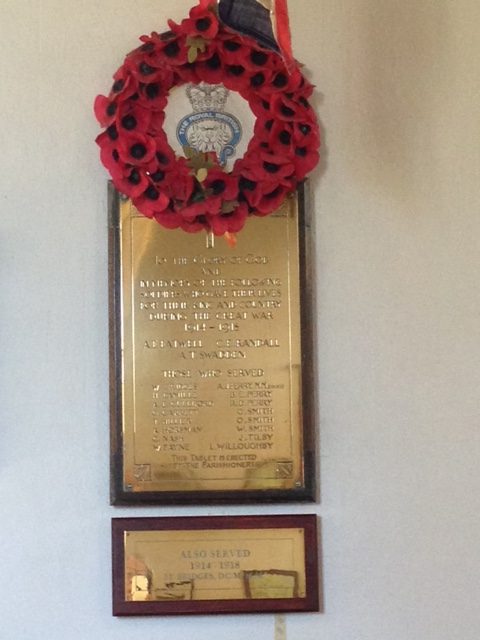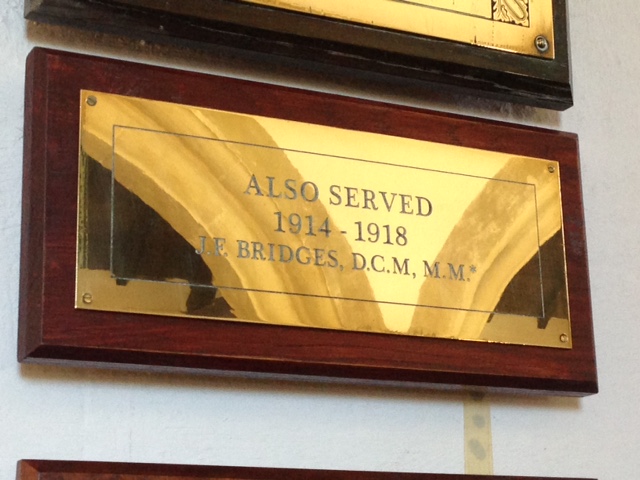C.E. Randall (C.H.P. Randall?)
1st Bn. Wiltshire Regiment, died of Wounds 13 October 1914, France
In the case of C E Randall, a mistake may have been made with his middle initial: The writer believes C E Randall was Charles Henry Portlock Randall (known as Charlie), born to Allan and Jane Randall (née Portlock) in Eisey, Wiltshire, in 1898. Although there were several soldiers in WWI documentation with the name of C E Randall, not one of those have a connection with this village.
Two Randall families lived in the village at different times but only one had a connection with a WWI soldier named Randall. The earliest Randall was Thomas Randall and his wife, Annie, who came to Winterbourne Bassett in the early 1890’s. Their first child, Florence Clara Randall, was baptised in the village in 1893 but their stay was brief, moving to Bedfordshire very soon after the birth of their second daughter, Nellie, in 1895. Her baptism took place elsewhere. Another four daughters were born in Bedfordshire before the birth of a son in 1908 who therefore would have been too young for military service in WWI. The family never returned to the village after their departure in about 1895 and they can therefore be discounted.
The other Randall who came to the village was William Charles Randall, brother of Charles Henry Portlock Randall who died during WWI. William married Lily Rose Eatwell in the village church in 1916. They both remained in the village. Another brother, Frank William, was present in the village for many years from 1926 (and was a registered voter in Berwick Bassett in 1918). As William, Frank and Charles’s parents had both died by the start of the war, Charles was listed on the plaque in St Katherine and St Peter’s by virtue of his brothers’ presence in the village and local area. Their surname is frequently spelled as Randell, Randel, Randal or Randall in official documentation.
C H P Randall, or ‘Charlie’, was resident in Swindon in August 1914. At the earliest opportunity, he enlisted in the 1st Battalion of the Wiltshire Regiment at Devizes. His service no. was 9048 and his battalion was located at Tidworth. It seems that he was not truthful about his age on enlistment and overstated his age as nineteen when he was actually sixteen years of age.
A wire confirming that Britain was at war was received at Tidworth Camp on 5 August 1914. The 1st Battalion, already on standby from the day before, began mobilisation in earnest and after several days of musketry training, drills, inoculations and inspections, two trains of soldiers finally left Tidworth during daylight hours on 13 August and delivered 1,014 soldiers of all ranks to shed 23 at Southampton docks where they embarked on the SS South Western and the SS Princess Ena and sailed for France arriving in Rouen the following day: the 14 August is the qualifying date for many Wiltshire soldiers awarded the 1914 Star Medal at the end of the war.
Several days of long marches and overnight billets eventually brought the battalion, as part of the 3rd Division of the 7th Brigade, to Ciply where the battalion billeted on the night of 22 August and began entrenching north of Ciply, facing Mons. During the following day and throughout the night of 23 August, the soldiers came under enemy shell fire. The earliest deaths of soldiers, officers and horses of the 1st Bn. of the Wiltshires were recorded on 24 August, 1914.
During the ensuing weeks, the battalion entrenched, retired, retreated and entrenched repeatedly in different areas, all their comings and goings, battles and skirmishes being recorded in the war diaries of the 1st Battalion Wiltshire Regiment. During the remainder of 1914, the battalion saw action at The Battle of Mons, The Battle of Le Cateau, The Battle of Marne, The Battle of Aisne and the Battles of La Bassee and Messines and the First Battle of Ypres.
On 6 October 1914, the battalion had arrived in Abbeville by train and during the next days marched on to La Triquerie Chateau, then on to Regrauville and Pernes, reaching Hinges on 11 October. Charlie ‘died of wounds’ on 13 October. In the absence of a service record, we shall never know whether he died as a result of wounds sustained on that day or from an earlier battle but, as his death occurred at a dressing station very close to the front line rather than at a field hospital behind the lines, it is likely that he died of wounds on the day he was injured: 13 October. Diary entries for 12 and 13 October reveal the action in which the soldiers of the 1st Bn. Wiltshire Regiment were engaged at the time of Charlie’s death.




